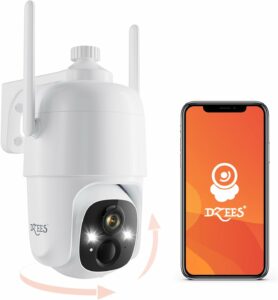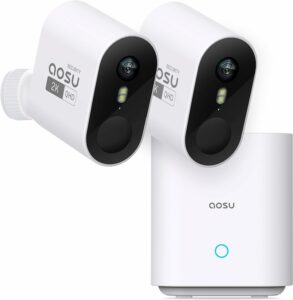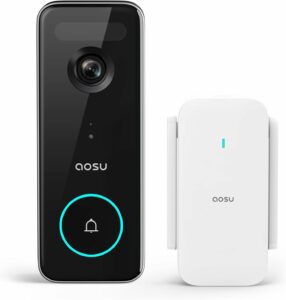Pros
- Interference Issues: Long-range wireless signals can be susceptible to interference from other devices or obstacles, potentially affecting the camera’s performance.
- Limited Power Options: Wireless cameras often rely on batteries or solar power, which may need frequent replacement or be weather-dependent.
- Potential for Signal Loss: In some cases, long-range wireless cameras may experience signal loss, especially in challenging environmental conditions.
- Flexibility: Long-range wireless cameras provide flexibility regarding installation locations, as they don’t require extensive wiring.
- Ease of Installation: Setting up these cameras is generally easier than wired alternatives, reducing installation time and effort.
- Remote Access: Many long-range wireless cameras offer remote access, allowing you to monitor your property from anywhere using a smartphone or computer.
Cons
Long-Range Wireless Security Camera
Introduction
Long-Range Wireless Security Cameras are purpose-built to transcend the limitations of traditional surveillance systems. Their introduction heralds an era where expansive coverage, unbridled flexibility, and uncompromising security converge seamlessly.
The imperative behind their development lies in addressing the escalating need for robust security measures across vast expanses, ranging from critical infrastructure and industrial facilities to expansive outdoor environments.
Provo Green Products embodies a beacon of trust in the realm of sustainable discoveries, offering choices that enhance your life and leave a positive mark on our planet.
Leveraging extensive expertise in manufacturing, construction, and various trades, we provide a solid foundation for sustainable living.
Our meticulous research process guarantees that our information about each product is precise and current, allowing you to make informed decisions.
Whether your interest lies in solar products, electric bikes, security, or other eco-friendly alternatives, our credibility commitment ensures access to dependable insights, guiding your journey toward a more sustainable lifestyle.
Provo Green Products is your go-to destination for finding the right green products for your lifestyle.
Disclosure: We may earn a small commission if you click on one of our links. This will not affect the pricing of the product whatsoever.
Key Features and Technologies
Wireless Connectivity Options:
- Seamless Integration with Wi-Fi and Cellular Networks
- Advanced Mesh Networking for Extended Coverage
- Dual-Band Support for Optimal Signal Strength
Advanced Camera Lens Technology:
- High-resolution imaging for Crystal-Clear Visuals
- Optical Zoom Capabilities for Detailed Observation
- Wide-angle lenses for Comprehensive Area Coverage
Infrared and Night Vision Capabilities:
- Infrared Sensors for Low-Light Environments
- Smart Night Vision Algorithms for Enhanced Visibility
- Adjustable Infrared Range for Precision Surveillance
Weather-Resistant Design:
- Robust Construction to Withstand Harsh Environmental Conditions
- IP65/67 Ratings for Water and Dust Resistance
- Operational Reliability in Extreme Temperatures
Motion Detection and Analytics:
- Advanced Motion Sensors for Intruder Detection
- AI-Powered Analytics for Anomaly Recognition
- Customizable Alerts Based on User Preferences
Power-Efficient Operation:
- Solar-powered options for Sustainable Energy Usage
- Low-Power Consumption during Standby Mode
- Battery Backup for Uninterrupted Surveillance
Remote Monitoring and Control:
- Mobile App Integration for Real-Time Monitoring
- Cloud-Based Platforms for Remote Access
- Two-Way Communication for Interactive Surveillance
Scalability and Integration:
- Expandable Systems for Growing Security Needs
- Integration with Existing Security Infrastructure
- Compatibility with Third-Party Monitoring Solutions
Tamper-Proof Design:
- Anti-Vandalism Features to Deter Unauthorized Interference
- Secure Mounting Mechanisms to Prevent Manipulation
- Tamper Alerts for Immediate Response

Installation and Setup Process
- Site Assessment and Planning:
- Conduct a thorough site survey to identify optimal camera placement.
- Assess potential obstacles and obstructions that may impact signal strength.
- Develop a comprehensive installation plan based on the specific surveillance requirements of the site.
- Choosing Optimal Locations:
- Select strategic vantage points that maximize the camera’s coverage area.
- Consider factors such as line of sight, potential blind spots, and environmental conditions.
- Ensure compliance with local regulations and privacy considerations when siting cameras.
- Network Configuration for Long-Range Coverage:
- Configure the wireless network settings to optimize long-range communication.
- Implement secure encryption protocols to safeguard data transmission.
- Conduct range tests to verify and optimize signal strength throughout the coverage area.
- Power Supply Considerations:
- Determine the most suitable power source for the cameras (e.g., mains, solar, battery).
- Ensure sufficient power backup options to prevent downtime during outages.
- Implement power management features for energy-efficient operation.
- Integration with Existing Security Systems:
- Coordinate the installation process with existing security infrastructure.
- Integrate Long-Range Wireless Security Cameras with surveillance software and control systems.
- Test interoperability to ensure seamless communication between components.
- Weatherproofing and Protection:
- Install weatherproof enclosures to shield cameras from the elements.
- Apply protective coatings to resist corrosion in challenging environmental conditions.
- Verify the camera’s IP rating for resistance against water, dust, and other environmental factors.
- Calibration and Alignment:
- Calibrate camera settings for optimal image quality and resolution.
- Align camera angles and focal points to meet surveillance objectives.
- Test and adjust motion detection parameters to minimize false alarms.
- User Training and Documentation:
- Provide training sessions for personnel responsible for monitoring and maintenance.
- Develop comprehensive documentation, including user manuals and troubleshooting guides.
- Ensure that end-users are familiar with the camera’s features and functionalities.
- Regular Maintenance Procedures:
- Establish a routine maintenance schedule for cleaning and inspections.
- Monitor system logs for any irregularities or malfunctions.
- Update firmware and software to benefit from the latest security patches and improvements.

Security and Encryption Measures
Encryption Protocols for Data Transmission:
- Implement robust encryption algorithms (e.g., WPA3) to secure wireless communication.
- Utilize end-to-end encryption to protect data in transit from the camera to the monitoring station.
- Regularly update encryption protocols to stay ahead of emerging security threats.
Protection Against Hacking and Unauthorized Access:
- Employ secure authentication mechanisms such as two-factor authentication (2FA) for access control.
- Utilize strong, unique passwords and regularly update them to prevent unauthorized access.
- Monitor and log access attempts, triggering alerts for suspicious activities.
Ensuring Privacy Compliance:
- Adhere to privacy regulations and guidelines relevant to surveillance practices.
- Implement privacy features such as zone masking to exclude sensitive areas from surveillance.
- Communicate transparently about data collection and storage practices to stakeholders.
Secure Firmware and Software Updates:
- Establish a secure process for updating camera firmware and software.
- Use secure channels to distribute updates and patches to prevent tampering.
- Schedule regular updates to address vulnerabilities and enhance system security.
Network Segmentation and Isolation:
- Segment the surveillance network to isolate cameras from other critical systems.
- Implement firewalls and intrusion detection systems to monitor and control network traffic.
- Restrict access to the camera network to authorized personnel only.
Secure Cloud Integration:
- If applicable, ensure secure integration with cloud-based storage and monitoring solutions.
- Encrypt data stored in the cloud using industry-standard encryption algorithms.
- Regularly audit and review cloud security settings and access controls.
Physical Security Measures:
- Implement tamper-resistant designs to deter physical manipulation or theft.
- Securely mount cameras to prevent unauthorized removal or tampering.
- Utilize anti-vandalism features to protect against physical attacks.
Regular Security Audits and Penetration Testing:
- Conduct regular security audits to identify and address potential vulnerabilities.
- Engage in penetration testing to simulate real-world attack scenarios.
- Collaborate with cybersecurity experts to stay proactive against evolving threats.
User Access Controls and Permissions:
- Implement granular user access controls based on roles and responsibilities.
- Regularly review and update user permissions to align with organizational changes.
- Disable unused accounts promptly to prevent unauthorized access.

Maintenance and Troubleshooting
Regular Inspections and Cleaning:
- Establish a routine inspection schedule to check for physical damage, dirt, or debris.
- Clean camera lenses and housings to maintain optimal image quality.
- Verify the functionality of moving parts such as pan-tilt-zoom (PTZ) mechanisms.
Dealing with Signal Interference:
- Identify and mitigate sources of signal interference, such as nearby electronic devices.
- Adjust wireless channels to minimize interference and optimize signal strength.
- Consider using frequency-hopping spread spectrum (FHSS) or other interference-resistant technologies.
Common Issues and Troubleshooting Tips:
- Compile a troubleshooting guide for common issues, including connectivity problems and image distortions.
- Provide step-by-step instructions for users to follow in case of system malfunctions.
- Establish a dedicated support channel for timely assistance with troubleshooting.
Firmware and Software Updates:
- Regularly check for and apply firmware and software updates released by the manufacturer.
- Schedule updates during low-activity periods to minimize disruptions to surveillance operations.
- Test systems thoroughly after updates to ensure continued reliability.
Power Supply Checks:
- Monitor power sources regularly and replace batteries or address power issues promptly.
- Conduct voltage and current checks to ensure stable power supply.
- Implement backup power solutions to prevent downtime during power outages.
Remote Diagnostics and Monitoring:
- Integrate remote diagnostic tools for proactive monitoring of camera health.
- Set up alerts for critical issues, allowing for swift response and resolution.
- Leverage remote access capabilities to troubleshoot and diagnose issues without on-site visits.
Weather-Related Maintenance:
- Assess the impact of adverse weather conditions on camera performance.
- Implement additional protective measures during extreme weather events.
- Schedule post-storm inspections to address any potential damage.
Record Keeping and Documentation:
- Maintain a detailed record of maintenance activities, including dates and performed tasks.
- Document troubleshooting processes and solutions for future reference.
- Use a centralized database or management system to track maintenance history.
Collaboration with Technical Support:
- Establish a direct line of communication with technical support from the camera manufacturer.
- Collaborate on resolving complex issues and seek guidance on troubleshooting procedures.
- Participate in training sessions provided by technical support to enhance troubleshooting skills.
User Education on Basic Maintenance:
- Educate end-users on basic maintenance tasks they can perform, such as cleaning camera lenses.
- Provide guidelines on when to contact technical support for assistance.
- Foster a proactive approach to maintenance through user awareness and involvement.

Conclusion
Long-range wireless Security Cameras stand as the vanguard of modern surveillance, seamlessly merging cutting-edge technologies with robust security measures.
From their advanced features and resilient designs to meticulous installation processes and stringent security protocols, these systems redefine the paradigm of safeguarding spaces.
As we embrace this era of unprecedented connectivity and vigilance, these cameras emerge not merely as tools but as guardians, fortifying our security infrastructure with unwavering reliability and advanced capabilities.
Stay in Touch!
I’am a dedicated entrepreneur with many years of experience and an integrity-driven individual who is highly motivated to succeed. Leveraging extensive expertise in manufacturing, construction, and various trades, we can provide a solid foundation for sustainable living. Our meticulous research process guarantees that our information about each product is precise and current, allowing you to make informed decisions. A deep understanding of business operations empowers me to consistently implement improvements that result in ongoing success. Visit site.

